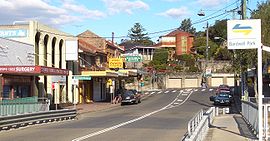Bardwell Park
|
Bardwell Park Sydney, New South Wales |
|||||||||||||||
|---|---|---|---|---|---|---|---|---|---|---|---|---|---|---|---|

Hartill-Law Avenue (eastern side shops)
|
|||||||||||||||
| Population | 2,242 (2016 census) | ||||||||||||||
| Postcode(s) | 2207 | ||||||||||||||
| Location | 12 km (7 mi) south of Sydney CBD | ||||||||||||||
| LGA(s) | Bayside Council | ||||||||||||||
| State electorate(s) | Rockdale | ||||||||||||||
| Federal Division(s) | Barton | ||||||||||||||
|
|||||||||||||||
Bardwell Park is a suburb in southern Sydney, in the state of New South Wales, Australia. Bardwell Park is located 12 kilometres south of the Sydney central business district and is part of the St George area. Bardwell Park is in the local government area of the Bayside Council. Bardwell Valley is a separate suburb, to the east.
Bardwell Park was named after free settler Thomas Hill Bardwell who owned land in the area. His grant was originally heavily timbered and bounded by Wolli Creek, Dowling Street and Wollongong Road. In 1881, the land was auctioned and 1,600 acres (6.5 km2) were subdivided. The railway station opened on 21 September 1931 which opened up the area for home sites. The school opened in September 1943 and the post office opened in May 1946.
Bardwell Park borders an important piece of remnant bushland, the Wolli Creek Valley, beside Wolli Creek. There have been active citizens' movements lobbying for its preservation in the face of demands for urban expansion. The most public of these prevented the building of the M5 South Western Motorway through the valley, resulting in the road being built as a tunnel under the valley. Nevertheless, community concern remains over what is seen as the release of particle pollution from exhaust emissions into the atmosphere in the Bardwell Valley.
The Wolli Creek Valley contains the only bushland of any size left in inner south-west Sydney. It is also the only large undeveloped natural space that remains in a heavily developed residential and industrial region. The park offers public transport access, family picnic areas, parkland, birdwatching, bushwalking, extensive views of sandstone escarpments, heathland and woodland forest. A 60 hectare regional park is under development.
...
Wikipedia
